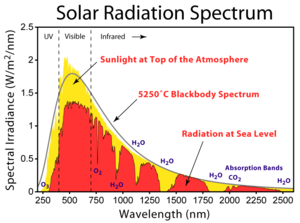Renewable energy/The energy challenge
The solar resource
[edit | edit source]Most of the renewable energy technologies use solar energy.
- The incoming solar radiation to the earth is 5.4x1024 J/year.
- 30% of this is reflected back into space.
- This leaves 3.8x1024 J/year remaining.
|
Question. How long does it take to deliver the annual global energy demand?
|
The graph below shows the wavelengths of solar radiation in different parts of the atmosphere.

|
Question 1. What is the photon energy in eV at maximum irradiance? Question 2. Why does the atmosphere attenuate visible light?
|
The need for renewable energy
[edit | edit source]1. Climate change
[edit | edit source]There are two important observations to be seen from this graph:
1. The earth's surface temperature has increased 0.6 ± 0.2 °C over the last century.
2. The earth's surface temperature is increasing at the highest rate ever since 1970.
Note that the actual increase depends on the model used and its assumptions made about global emissions.
Warming over the last century has been linked to large scale changes in the large scale hydrological cycle:
- Increasing atmospheric water vapour content
- This has resulted in:
- Precipitation has increased over land in high northern latitudes, while decreases in precipitation have dominated from 10°S to 30°N since the 1970s.
- The frequency of heavy precipitation events has increased in most areas.
- Globally, the area of land classified as very dry has more than doubled since the 1970s.
- This has resulted in:
- Widespread melting of ice
- Significant decreases in water storage in mountain glaciers and Northern Hemisphere snow cover.
- Rising sea levels (0.9 cm/year) pose a serious risk to people living in coastal cities, including London, New York, Mumbai, Shanghai, and a few low lying countries.
- This is due to the emission of soot (particulates) which increases the rate of melting, as soot on the ice surface absorbs sunlight.
- Increased acidification of the oceans
- Caused by the uptake of CO2 from the atmosphere (CO2 + H2O → H2CO3)
Why warming?
[edit | edit source]
- The earth absorbs sunlight
- Then it re-emits infrared (IR) radiation (heat)
- This is because the IR radiation causes vibrational excitation of carbon dioxide (and other greenhouse gases) molecules.
- The molecule emits heat isotropically.
Significance of carbon dioxide
[edit | edit source]
- Radiative forcing is the difference in heat capture 'now' versus 'then'. In other words, it describes how the balance between incoming and outgoing energy has been changed.
- Positive forcing warms the earth's surface.
- Carbon dioxide is the most important radiative forcing component because it has a 100 year lifetime in the atmosphere.
- Methane has a shorter lifetime at 8.4 years, but is much more potent than carbon dioxide.
- This is why carbon dioxide and methane are classified as 'long-lived anthropogenic greenhouse gases'.
Energy consumption
[edit | edit source]
The world is slowly reducing its dependence on the 'dirtiest' form of energy, coal.
But why are carbon dioxide levels set to rise so dramatically?
Demand for energy is driven by a huge increase in the population of developing nations.
We need to become less reliant on fossil fuels quickly! History tells us that changes in industrial infrastructure take time: it took 100 years for electricity to become common place.
- Governments must intervene (called market externalities'):
- Japan and Germany have government backed incentives to use renewable energy
- India are using solar water heaters
- The UK have set a target to reduce greenhouse gas emissions by 80% by 2050
- Populations must be pro-active in behavioural change
2. Depletion of conventional fossil fuel sources
[edit | edit source]Demand for fossil fuels will increase dramatically if alternatives are not forthcoming, accelerating the depletion of these resources.
For example, India and China have a combined population of 2.4 billion, and currently account for 12% of world oil consumption.
Personal car ownership in India and China is around 10 per 1000 eligible drivers. Personal car ownership in the USA is 1024 per 1000 eligible drivers. As the former figure increases, they need to use an extra 100 million barrels of oil per day! Current consumption of oil is 83 million barrels per day.
3. Security of supply
[edit | edit source]There is an uneven distribution of conventional energy sources around the globe. In other words, things like oil, gas, uranium are not equally distributed across continents and nations.
A heavy dependence on just a few countries for these resources poses energy security risks'.
Along with this, price and volatility of supply presents economic risks.
These concerns encourage countries to:
- harvest their own domestic resources (e.g. coal in Poland)
- specialize (e.g. Brazil use sugarcane for ethanol as a fuel)
Addressing the energy challenge
[edit | edit source]- Reduce demand
- Efficiency improvement
- Behavioral change
- Innovations
- Increase proportion of energy generated by sustainable sources
- Implementation of existing technologies (e.g. wind turbines)
- Development of new ones
